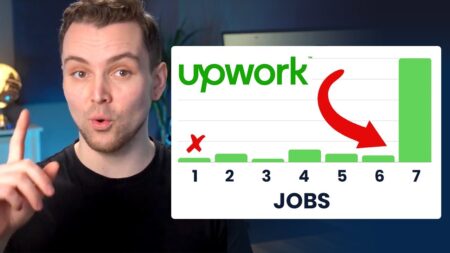The feast or famine cycle is the burden bearing down on many freelancer’s backs. However, that doesn’t mean freelancing isn’t a wonderful way to make your money.
You get to parlay your specific skill set and interests in the marketplace, you have a lot of control over your work schedule, and you have control over your workspace.
Friends and family may wonder, especially when you’re first starting, if this is a realistic way for you to pay your bills. After all, freelancing is highly insecure, right? Of course, any dedicated freelancer has a canned answer for these concerns.
Usually, the answer is even a good one. There’s a ton of demand for my skill set. Working for multiple clients helps keep my work fresh and allows me to build new marketable skills.
I’m making more than enough, and I’ve put money away for a rainy day. Don’t worry about me.
What Is the Feast or Famine Cycle?
We all know that freelancing can be a riskier way of bringing home the bacon. Contracts end, clients decide to bring in a traditional employee to do the work they used to send to you.
You sink every waking moment into a project that lasts three months but once you’ve turned in the work you have nothing lined up.
That’s the feast or famine cycle. And it’s not just about how much work you have, it can literally be a matter of how much food you can put on the table.
While the feast and famine cycle is part of freelancing, it doesn’t have to be part of your freelancing career.
There are a few, relatively simple, steps you can take to make sure you spend most of your time feasting. While these tricks won’t eliminate slow months entirely, they can certainly help your downtime feel less like a famine.
How to Escape the Feast or Famine Routine
It’s an unfortunate truth that many freelancers never escape the feast or famine treadmill. A marketing and self-promotion binge leads to crazy workloads and sleep-deprived marathons toward deadlines, followed by a dry patch with no work.
Of course, when you don’t have any work, you start on the marketing and application binge again and the cycle continues.
These steps will help you escape the feast or famine trap. Or, if you’re a new freelancer, you can use them to avoid entering the feast or famine cycle in the first place.
Never Stop Looking for Work
This is the number one mistake freelancers, especially new freelancers make. While you might not have the time to take on a new client right away, it’s still worth looking for jobs that might be a good fit.
With time being so limited, using a job site like SolidGigs will allow you to continue working and let someone else do the searching for you. Sit back, do your work, and let the jobs come to you — sounds nice, right?
If you find something that looks promising, go ahead and apply for the job. In your pitch, make sure you include when you think you’ll be able to start working on the client’s project, and how long you think it will take you to complete it.
While many clients are looking for freelancers that are available to take on projects right away, not every client needs an immediate turnaround.
If you’re a good fit for their project, and you pitch yourself well, they might be willing to wait for your work rather than risking it on a less qualified freelancer who can start right away.
Even if prospective clients don’t take you on, they’ll likely consider you for future projects. Many clients, especially big corporations, will need the same sort of work over and over again.
Even if they only contact you when their regular freelancer is on vacation, it’s still another income stream.
Look for New Marketplaces for Your Talents
This should be part of your regular job search. In addition to looking for new clients, you should also look for new platforms to market your skills on as many freelance job sites as possible.
If you aren’t already utilizing social media as a freelancer, you should start. Today. You’d be surprised how many people you already know might be looking for someone with your skill set.
Or, they’ll know someone who needs freelance work and they’ll send it your way. We’ll talk more about social media in a minute.
But, whether it’s a local job postings board, a freelancer website, or giving local business owners a copy of your card, you should always be looking for new places to find clients. The more potential clients you have, the more job opportunities you’re likely to net.

Look to Raise Your Prices
As many freelancers quickly find out, your starting pay is typically less-than-fantastic. This is especially true if you’re developing in a new field that you don’t have much experience in.
It’s totally normal, but don’t get complacent with yourself and the rates you’re currently charging.
As you gain more experience in freelancing, you should look to develop a niche field. This will help you focus your talents and efforts on improving one thing rather than many.
After you’ve developed yourself in your given field, it’s time to start raising your prices. Just like you would in a more stereotypical work environment, ask for more money once you’ve proven you’ve deserved it.
This can be tricky because it remains up to you to decide when you think you deserve more than you earn. Remember to not break the current gigs you have going for you.

As a freelancer, you have the ability to demand the money you believe you’re worth when beginning work with a new client, this will be the most opportune time for you to start slowly raising your rates.
It can be imperative to removing yourself from the feast or famine cycle. More money earned means more money in the bank and less time you’ll have to worry about fending for yourself when you find yourself in a work-lull.
Gain Long-Term Contracts
This is the piece of advice that may help you entirely avoid a feast or famine cycle. By gaining long-term contracts you’ll be guaranteeing yourself a source of income even when other work slows down.
This can frequently be an issue during the holiday season, which, of course, is most likely the worst time to be earning less money.
Long-term contracts can range from a few months to indefinitely, depending on your field of work. Indefinite is the preferred long-term contract because it’s a guarantee on your income. However, these can be difficult to adjust your rates with, especially if you’re starting. But, they’re great for keeping yourself afloat.
It’s always a good idea to have a long-term contract you’re working on that has a definite end date. This will mean you’ll have more time to think ahead and plan to take on another client, which is a great time to adjust your rates accordingly.
Integrating long-term contracts into your freelancing workload is almost a must, and it can help incorporate making more money into your short-term goals. A win-win for you in almost every case.
Keep Working Through Slow Times
It’s easy when you don’t have a lot of deadlines coming up, to kick back and give yourself a break. That’s all well and good and may even be beneficial for a couple of days.
But you should resist the temptation to do nothing but relax and market yourself while you’re looking for new work.
Take the opportunity to reduce the pile of unopened envelopes, catch up on your bookkeeping, and reorganize your desk. Get a paper shredder if you don’t already have one and work your way through the papers lying around at your office.
Slow periods are also a good time to work on side projects, explore new income streams, learn new skills, and earn new certifications. While you may not need to add to your skillset to pick up new jobs, it can make you more attractive to clients.
Plus, you never know when you might find a better income or stronger passion with a new skill. Since you have the opportunity to work for yourself, you also have the freedom to let your professional life evolve along with your personal life.
Dedicate Some of Your Time to Marketing
Instead of only marketing yourself when you need new clients (i.e. when you’re in a famine), try to incorporate marketing into your regular work routine.
Many freelancers like to set aside a day of their workweek that is entirely dedicated to this task. Alternatively, if an entire day of marketing work sounds intimidating, try to set aside a couple of hours each day that you can work on boosting your presence.
There are lots of ways to market, and you should try to use multiple marketing platforms. Each platform has different strengths and weaknesses and different clientele.
Start a Blog
Even if you aren’t a freelance writer, a blog is a good way to market what you can do. Whether you’re a coding specialist, a graphic designer, or a freelance accountant, taking some time to talk about what you do online is a good way to convince clients you know your business.
Depending on your specialty your blog can be instructional, or it can act more like a digital portfolio of your work. Even if your blog is more of a portfolio, you should also maintain a content portfolio on each of the online marketplaces you use.
It’s also a good idea to take the time to post regularly on your blog. Posting regularly will help drive traffic, potentially turning your blog into an independent income stream of its own.
Regular posts will also help convince your clients that you’re a reliable freelancer.
Many of the big clients you’ll work with will have been burned on a deadline or content quality in the past. Having a blog you tend regularly, and which showcases your talents at their best, will increase their confidence that they’re getting what they’ve paid for.
Use Social Media
Many freelancers only maintain an online presence on freelance marketplaces and professional networking sites like Linkedin. While Linkedin is certainly a powerful tool in the freelance world, Twitter, Facebook, and even Instagram shouldn’t be overlooked.
There are a couple of reasons for this. Increasingly, big clients are using other digital platforms to find contractors and freelancers. This is still a small percentage of overall scouting, but you never know when an offer might come your way.
More importantly, maintaining a professional social media presence will help remind friends, acquaintances, and past clients, of your skillset.
You’d be amazed at how quickly people can forget that they know someone who designs websites, writes online course materials, or codes.
Social media is a way to remind your existing network of what you do. That way, when job opportunities come their way, they’ll be more likely to send them on to you.
You can also use professional social media pages as a supplemental content portfolio. Some clients will feel more confident about their chosen freelancer if they can see that freelancer in several contexts before hiring them.
Social media is also a great place to post reviews and client reactions. Reviews of your work help future clients see that the work you produce is consistently what your clients are asking for.
A top-notch graphic is only useful if it meets client requirements, after all. Just seeing that you can design isn’t necessarily enough to convince clients that you can handle their design.
Remember Your Past Clients
This is simple, but also incredibly easy to overlook. Acknowledge your clients. You’ve built a working relationship with them, especially if you’ve taken on long-term projects with them.
It’s worth checking in at the end of a project to thank them for the opportunity to work together.
Not only is saying thank you a good way to leave your clients happy with your work and the interaction, but it’s also an opportunity to remind them that you might be available for future work.
While some clients will feel confident reaching out to freelancers they’ve hired previously, others need some encouragement.
Reminding them that you’d be happy to help with future projects is simple and may net you some income down the line. By keeping an open line with past clients, you’ll have more of a workload in the future to prevent the feast or famine cycle from bearing down upon you.
Network with Other Freelancers
This is another overlooked tool. Networking, not just with potential clients, but with other freelancers will help keep you working.
Certainly, you should know other freelancers doing the same kind of work you do. But, it’s also a good idea to know freelancers with other specialties, especially specialties that overlap with yours.
If you’re a freelance graphic designer, for instance, it would be a good idea to know a few freelancers who specialize in website development and maintenance.
Knowing your fellow freelancers gives you access to immediate advice and support, for one thing. That can help you turn out higher quality work when you’re in a tough spot.
Have a client that didn’t provide clear project goals, and you can’t seem to get more detail out of them? Talking with other freelancers who’ve been in a similar spot can help you figure out a way to meet and exceed your client’s expectations.
The same principle goes the other way. If your client is micromanaging the project and trying to steer you in a direction you think will be less successful, your fellow freelancers might have ideas for how you can please your client and keep the project on a successful trajectory.
Networking is also a great way to get jobs. Freelancers like to recommend other freelancers if they are asked about a job they can’t do. You might have a colleague refer you to their client because their schedule is too full to take on an additional project.
Or, a freelancer in a different field might recommend you if they’re asked to take on a job outside of their specialty.
You should try to return the favor, of course. Other freelancers are more likely to think of you if they know you’ll also send work their way when the opportunity arises.
Keep Your Portfolio Up To Date
Updating your portfolio may seem like a tedious task, especially if you regularly produce a large amount of content.
But, it’s incredibly important to keep your work fresh. Not only should you have a portfolio, but it should represent the best of your work. As you gain new skills and polish your existing ones, include new content that shows off those abilities.
You should also avoid just adding new files and never cycling older portfolio content out of the way. After all, the content you were producing a year ago may look nothing like the content you’re putting out today.
Don’t risk clients seeing an outdated version of what you can do. Schedule time to go over and improve your portfolio regularly to cut the feast or famine cycle from your life.
Don’t Be Afraid to Subcontract Your Work
We’ve already talked about how important it is to know other freelancers. This is another reason to network with fellow freelancers and to know freelancers in a range of specialties.
Sometimes you will have a client that needs a lot of work done very quickly. Or, they have a big project with lots of separate parts and want to have one person managing the whole thing for the sake of consistency.
In these situations, you can often subcontract parts of the project to other freelancers with the required specialties.
Of course, you should let your client know that while you are overseeing the whole project, and will make sure their content standards are met, you do plan to subcontract parts of the work to other freelancers.
Partially this is just for the sake of transparency. You don’t want your clients thinking that you alone did the work of a half-dozen freelancers.
It also allows clients to say no or offer you a longer timeline to complete the work yourself. That way, you don’t have to subcontract at all.
Some clients will also be interested to know the other freelancers you trust to get the job done. Providing those referrals, when you take on large projects, is a great way to show appreciation for other members of the freelancing community.
Overall, subcontracting your work can reduce your time spent on projects while also allowing yourself to take on a larger workload. More work, more clients, more success, less feast or famine.
Budget for Famine
If you successfully implement these tips you should be able to build a successful business with a great deal of consistency. But, even after you’ve broken out of the feast or famine cycle, you’re still likely to encounter the occasional slow period.
The first thing to remember when work slows down is this: Don’t Panic.
Practically every freelancer has had a slow month or two. Most experienced freelancers have had several rough patches. Many spend years in the feast or famine cycle before building a consistent business plan that works for them.
It’s important to remember that you aren’t the only person this has ever happened to. It’s a normal part of this business, and it will pass.
But, before you find yourself in a famine or even a slight slowdown, you should budget for it. There are two ways you can do this.
The first is to set aside a little money out of your existing budget to create a rainy-day fund. You should try to, at a minimum, have a month of rent, bills, and your other normal expenses set aside.
Be sure to include some money for leisure in this fund. Slow months are stressful. You’ll want to do something to take your mind off work.
The other alternative is to increase your current workload or your current rate and put the new income into your rainy-day fund.
It’s a good idea to budget your time so that you don’t have to work every day of the week to afford your current lifestyle. Try to cut your necessary work time down to three-four days a week.
That doesn’t mean you should change your work schedule, keep working the hours you would normally.
But, that extra-budgetary income will help with slow periods. It can also be used to supplement your retirement fund, go on vacation, or help your kids with college.
The less your time is spent earning the money you need and the more is spent earning the money you want, the better. Knowing you have those surpluses will help make slow periods easier, which will in turn cut the feast or famine cycle out of your life.
Final Thoughts
No matter where you are in your freelance career, or how many times you’ve worked your way through the feast and famine cycle, you can make freelancing a steady career with a regular (enough) paycheck.
How exactly you do that is up to you.
These tips are a great springboard but don’t be afraid to deviate if you think of something that works better for you. Include the parts that make sense, ditch the parts that don’t, and keep working at it until you get it right.
Keep the conversation going...
Over 10,000 of us are having daily conversations over in our free Facebook group and we'd love to see you there. Join us!




